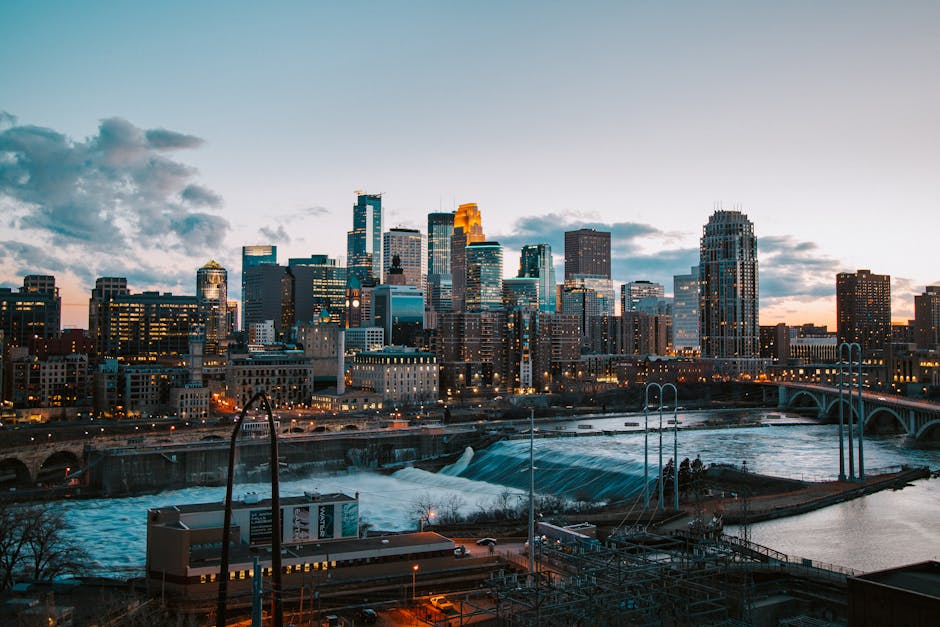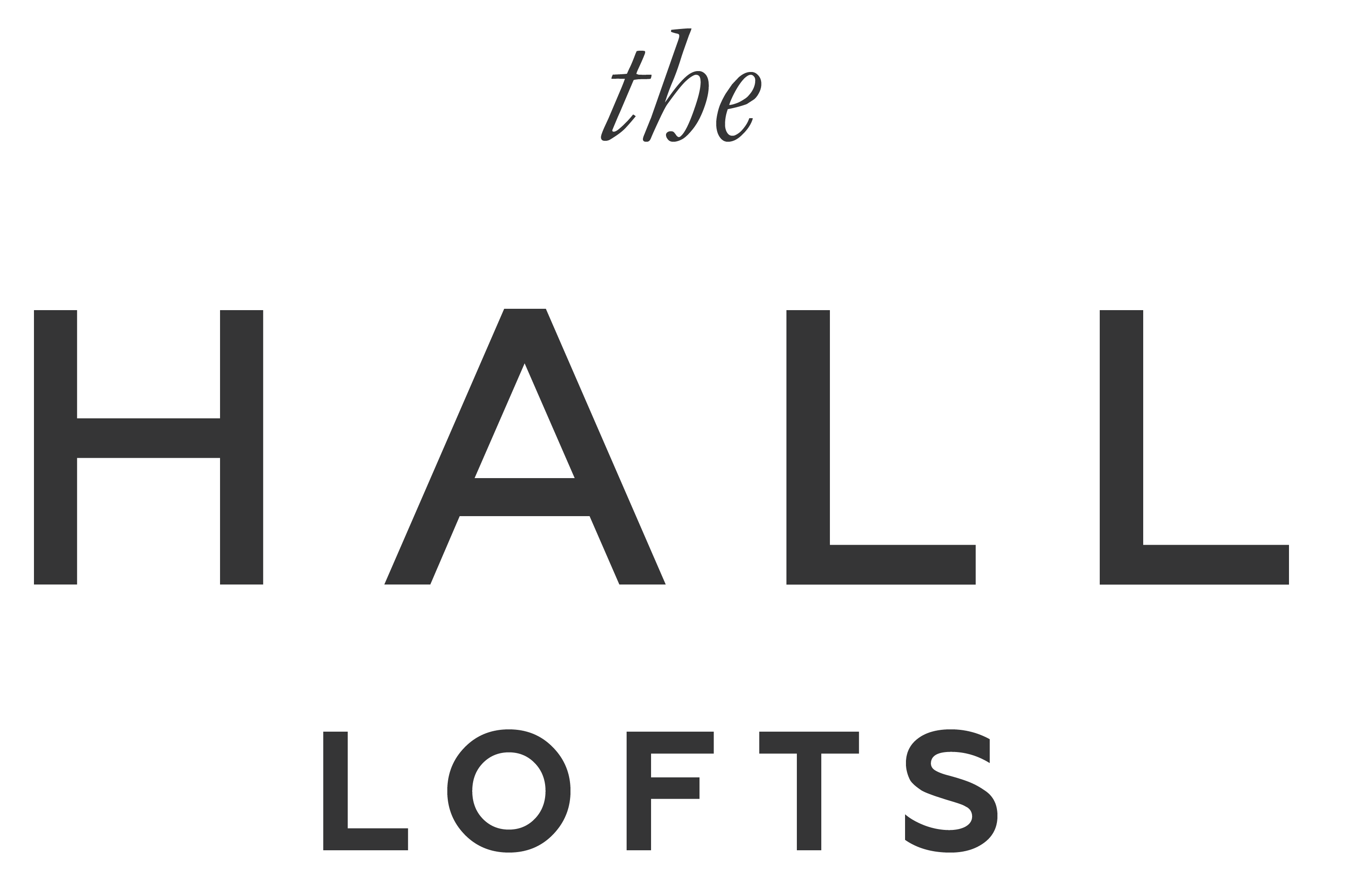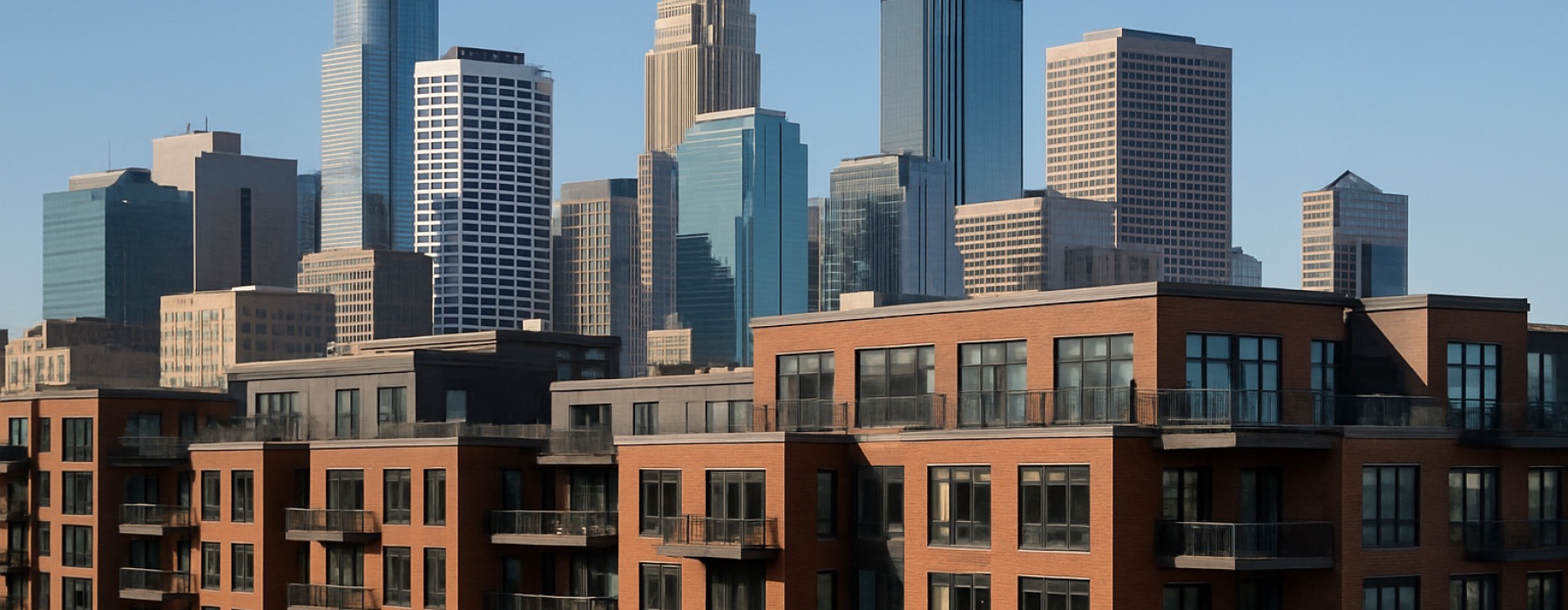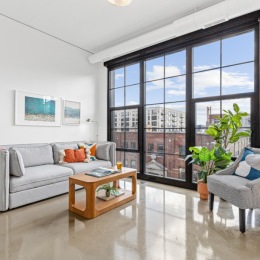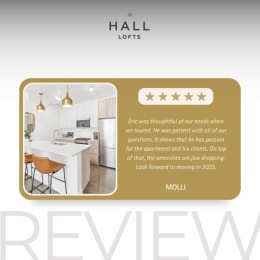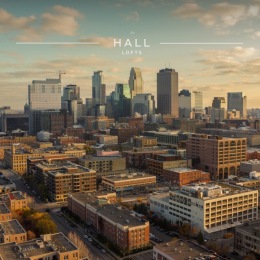Experience the Urban Renaissance of Downtown Minneapolis Lofts
Downtown Minneapolis lofts offer a unique living experience that blends historic industrial character with modern urban convenience. If you're exploring loft options in Minneapolis, here's what you need to know:
- Defining Features: High ceilings (12-20 ft), exposed brick walls, original wooden beams, and large factory windows
- Popular Neighborhoods: North Loop, Mill District, Warehouse District
- Pet-Friendly Options: Most buildings welcome pets, often with designated amenities like dog parks
- Must-Have Amenities: In-unit laundry, rooftop decks, fitness centers, community spaces
Downtown Minneapolis has transformed its industrial past into an urban renaissance, with historic warehouses and factories now housing some of the city's most sought-after residences. These architectural gems combine original character with contemporary comforts.
"The lofts offer 'lots of character' compared to other living environments," notes one property description, highlighting what draws so many urban professionals to these unique spaces.
The North Loop neighborhood stands out as a particular hotspot, with its cobblestone streets and award-winning restaurants creating a vibrant backdrop for loft living. Meanwhile, the Mill District offers stunning Mississippi River views and access to the iconic Stone Arch Bridge.
What makes these spaces special isn't just their location or aesthetic—it's the lifestyle they enable. Imagine hosting friends on a rooftop deck overlooking the city skyline or working remotely with abundant natural light streaming through oversized windows.
Whether you're seeking a studio or a three-bedroom space, downtown Minneapolis lofts offer the perfect blend of historic charm and modern convenience for today's urban dweller.

Downtown Minneapolis Lofts: History, Definition & Character
The story of Downtown Minneapolis lofts is deeply rooted in the city's industrial past. These spaces—once busy warehouses, grain mills, and factories—have been thoughtfully transformed into some of the most distinctive living spaces you'll find in the Twin Cities.
What Defines a Downtown Minneapolis Loft?
True Downtown Minneapolis lofts offer so much more than just an apartment with an open floor plan. When you walk into an authentic loft, you'll immediately notice the distinctive architectural elements that set these spaces apart:
Soaring ceilings that reach up to 12-20 feet create an airy, expansive feel you simply can't find in conventional apartments. Look up, and you'll see exposed structural elements—original brick walls, wooden beams, and even ductwork—that tell the story of the building's industrial origins.
Massive, oversized windows flood these spaces with natural light, while open floor plans with minimal interior walls allow you to customize your space to suit your lifestyle. What makes these spaces truly special are the original industrial features like concrete floors or metal fixtures that have been preserved rather than removed.
"Each unit retains historic warehouse character combined with modern finishes," as one North Loop property puts it—capturing the perfect balance between honoring history and providing modern comfort.
Unlike cookie-cutter apartments, lofts accept their industrial roots rather than hiding them. While a typical apartment might feature uniform layouts and neutral finishes throughout, each loft celebrates its unique quirks and character.
| Feature | Lofts | Condos | Apartments |
|---|---|---|---|
| Ceiling Height | 12-20 ft | 8-10 ft | 8-9 ft |
| Floor Plan | Open concept | Defined rooms | Defined rooms |
| Character Elements | Exposed brick, beams | Varies by building | Limited |
| Ownership | Rent or own | Own | Rent |
| HOA/Building Fees | Often higher | Standard | Included in rent |
| Customization | Limited in rentals, extensive in owned | Extensive | Limited |
From Grain Mills to Glam: A Brief History
The change from industrial facilities to coveted urban homes began in the late 20th century as Minneapolis' manufacturing landscape evolved. As the city's economy shifted, many historic buildings sat vacant—creating the perfect opportunity for forward-thinking developers.
The Warehouse District wasn't always a trendy residential neighborhood. True to its name, it once served as the beating heart of Minneapolis' commercial activity—a hub of warehousing and manufacturing that fueled the city's growth. Many of these buildings date back to the late 1800s and early 1900s, when Minneapolis was making its name as the flour milling capital of the world.
Take the Sexton Lofts, for example. What was once a busy warehouse became 123 unique condominium units in 2006, with developers carefully preserving the original brick exterior and industrial character that makes the building special.
The Smyth Lofts building tells a similar story. Built in 1885 as the Baker Importing Company, this structure housed everything from a coffee importer to a book bindery before being reimagined as 21 distinctive loft homes, each with its own character.
The adaptive reuse movement really took off in the 1990s and 2000s. Developers began to recognize not just the historical significance of these buildings, but their incredible potential as one-of-a-kind living spaces. Today, these conversions represent some of Minneapolis' most successful urban renewal stories—breathing new life into historic structures while creating vibrant communities where people love to live.
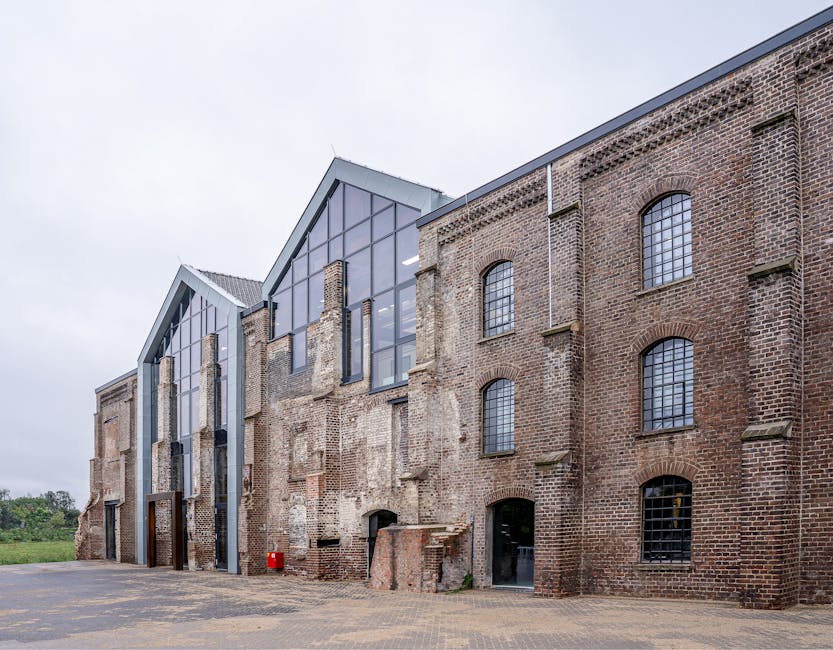
Mapping the Neighborhoods: North Loop, Mill District & Beyond
Finding your perfect Downtown Minneapolis loft starts with understanding each neighborhood's unique personality. Each district offers its own blend of architecture, amenities, and atmosphere that shapes the loft living experience.
North Loop Warehouse Charm
The North Loop has become the undisputed heart of Minneapolis loft living. This former industrial hub now pulses with urban energy while carefully preserving its historic warehouse character.
What gives the North Loop its special magic? Think historic warehouses transformed into one-of-a-kind living spaces, with cobblestone streets that tell stories of the neighborhood's industrial roots. Food lovers rejoice in the James Beard award-winning restaurants dotting the area, while shoppers explore boutique stores showcasing local designers. And for baseball fans, Target Field sits just steps away, bringing Minnesota Twins action right to your doorstep.
The Hall Lofts perfectly captures this neighborhood's essence, spanning three beautifully renovated buildings where historic character meets modern design. As one resident puts it, "The North Loop arts and dining scene is right outside my door, but I still get to come home to a space with character and history."
Another neighborhood gem, 724 Lofts, operates as a "campus" where residents enjoy amenities across multiple buildings. Built in 1892 and thoughtfully updated in 2022, this National Historic Register property gives its 49 households a tangible connection to Minneapolis' rich past.
Mill District River Views
East of the North Loop, the Mill District showcases Minneapolis' flour milling heritage while offering a slightly different loft lifestyle. Here you'll find:
Mississippi Riverfront access creates a playground for walkers and cyclists, while dramatic views of the water and St. Anthony Falls provide a natural backdrop to urban living. The area's crown jewel, the Stone Arch Bridge, connects both riverbanks and serves as the city's most photographed landmark. Cultural enthusiasts appreciate proximity to the Guthrie Theater and Mill City Museum, while those seeking tranquility enjoy the peaceful green spaces lining the waterfront.
Mill District lofts often feature stunning river panoramas that change with the seasons. Property descriptions in this area frequently highlight "the relaxed side of the Minneapolis skyline," offering residents serenity while remaining just minutes from downtown's energy.
Ironclad Apartments honors the district's industrial roots in both name and spirit. The building stands where the Union Grain Elevator once operated in 1867—a structure that burned down after a decade and was rebuilt with protective iron cladding, inspiring both the property's name and its safety-conscious design philosophy.
Warehouse District Nightlife Hub
While sharing geography with parts of the North Loop, the core Warehouse District has developed its own distinct personality centered around entertainment and nightlife.
The area hums with a vibrant club scene featuring live music venues for every taste. Diverse dining options range from casual bites to sophisticated cuisine. Theater and performance spaces showcase local talent, while art galleries housed in former industrial buildings celebrate creativity in all forms. For professionals, the area offers easy access to downtown's business district.
Warehouse District lofts tend to attract those who accept urban energy. Take Robitshek Lofts, housed in a historic textile factory—just 12 spacious apartments featuring exposed brick, soaring ceilings, and original hardwood floors, perfect for residents who crave authentic character in the heart of the action.
Whether you're drawn to the North Loop's trendy vibe, the Mill District's scenic beauty, or the Warehouse District's energy, Apartments Near Downtown Minneapolis offer something for every urban lifestyle preference.
Pricing & Market Trends
The financial landscape of downtown Minneapolis lofts offers something for every budget and lifestyle. Whether you're considering renting or buying, understanding current market conditions will help you make the right choice for your urban living trip.
Renting vs Buying: What Fits Your Budget?
When it comes to calling a downtown Minneapolis loft home, you've got two paths to choose from—each with its own set of financial considerations.
Renting offers wonderful flexibility for urban explorers. You'll enjoy the freedom of shorter commitments (typically 6-12 months) and significantly lower upfront costs compared to purchasing. Most rental lofts come with included amenities like fitness centers and community spaces that might otherwise add to your monthly expenses. Plus, when the dishwasher breaks or the HVAC system needs attention, that's your property manager's problem, not yours!
"I love that I can enjoy all the character of my North Loop loft without worrying about maintenance," shares one Hall Lofts resident. "And when my job situation changes, I'm not tied down by a mortgage."
On the flip side, buying a loft means building equity with each payment rather than watching rent money disappear. Homeowners enjoy valuable tax advantages through mortgage interest deductions and the freedom to customize their space. Many loft owners view their purchase as both a home and an investment in Minneapolis' thriving urban market.
The Sexton Lofts represents an approachable entry point for ownership in central downtown, with units ranging from cozy 760-square-foot spaces to sprawling 2,200-square-foot residences. For renters, The Hall Lofts offers thoughtfully designed studios, one-bedroom, and two-bedroom options in the vibrant North Loop, complete with modern conveniences like in-unit laundry and high-speed internet.
Market Trends: Downtown Minneapolis Lofts Outlook
The downtown Minneapolis lofts scene continues to evolve in exciting ways, with several trends shaping its future:
Luxury amenities have become the new standard. Buildings like North Loop Green 360 now feature rooftop pools, fitness centers, and saunas—elevating urban living to resort-style experiences. The competition for residents has pushed developers to create increasingly impressive shared spaces.
Work-from-home culture has transformed loft design. With remote work becoming permanent for many professionals, flexible floor plans and dedicated office nooks have gained tremendous popularity. Those signature loft features—high ceilings, abundant natural light, and character-rich backgrounds—create impressive Zoom meeting settings that colleagues can't help but comment on.
Community-building has taken center stage. Today's loft residents want more than just a place to sleep; they crave connection. Newer developments like Groove Lofts have responded with creative shared spaces including maker's studios, arcades, and even karaoke lounges. These thoughtful touches help transform buildings into true communities.
The balance between historic charm and modern convenience remains the sweet spot for successful loft conversions. Smyth Lofts perfectly captures this appeal with their marketing promise of "the perfect blend of classic style and modern living." Urban dwellers clearly want authentic character without sacrificing today's comforts.
Pet-friendly policies have become nearly universal across downtown lofts. As more city dwellers add furry family members, buildings have responded with dedicated pet amenities. North Loop Green 360 even highlights its direct access to the neighborhood dog park as a key selling point.
The market outlook remains bright for downtown Minneapolis lofts, particularly in the North Loop and Mill District. These neighborhoods continue to attract residents with their winning combination of historic industrial character, thoughtful modern updates, and vibrant street-level energy.

Signature Amenities & Urban Lifestyle
Life in Downtown Minneapolis lofts goes far beyond just having a cool place to hang your hat. It's about embracing a lifestyle where historic industrial charm meets modern convenience—a perfect blend that creates something truly special.
Signature Features & Amenities
When you walk into a genuine downtown loft, you immediately notice what makes these spaces different from cookie-cutter apartments. The exposed brick walls tell stories of Minneapolis' industrial heyday, while original wooden beams stretch overhead, supporting ceilings that soar 12-20 feet high. These aren't features you can recreate in new construction—they're authentic pieces of the city's history.
Natural light floods through oversized factory windows, creating bright, airy spaces that feel expansive and welcoming. Many residents find these windows become their favorite feature, especially during Minnesota's long winters when natural light is precious.
"I never get tired of the way the afternoon sun hits my brick wall," shares one North Loop resident. "It gives the whole space this warm glow that just feels like home."
But today's loft living isn't about sacrificing modern comforts for character. Most Downtown Minneapolis lofts seamlessly integrate contemporary amenities like updated kitchens with sleek appliances, spa-inspired bathrooms, and smart home features. Nearly all include in-unit laundry—a convenience that becomes even more appreciated during snowy Minnesota winters.
Community spaces have become increasingly important in loft buildings. Rooftop decks offer breathtaking views of the Minneapolis skyline and create natural gathering spots for residents. Many buildings feature fitness centers, co-working lounges for remote workers, and club rooms perfect for hosting gatherings too large for individual units.
The Hall Lofts perfectly captures this balance across its three distinct buildings—The Newell, The Falk, and The Martin. Each building maintains its unique warehouse character while offering thoroughly modern conveniences that make daily life easier and more enjoyable.
Pets, Parking & Perks
Let's talk about the practical stuff that makes a big difference in day-to-day living.
First, the furry family members. Most Downtown Minneapolis lofts welcome pets with open arms, recognizing that four-legged companions are part of the family. The Hall Lofts allows up to two pets per apartment, and many buildings go further with dedicated pet washing stations or relief areas—because nobody wants to take their dog out in -20° weather any longer than necessary!
Parking is gold in downtown areas, and loft buildings handle this differently. Some offer dedicated underground garages, while others use nearby contract parking. The Sexton Lofts takes an interesting approach by arranging parking at a neighboring building, which allowed them to use their rooftop for resident amenities instead.
Storage solutions become particularly important in open-concept loft spaces. Buildings like Smyth Lofts highlight their additional on-site storage areas, giving residents places to stash seasonal items, sports equipment, or those boxes you're not quite ready to unpack.
Higher-end loft buildings often include concierge services that add a touch of hotel-like luxury to daily life. From accepting packages to coordinating dry cleaning pickup, these services make urban living more convenient and stress-free.
Many renovated warehouses also incorporate surprising eco-friendly elements. Energy-efficient windows maintain the historic industrial look while providing modern insulation, and water-saving fixtures reduce both environmental impact and utility bills.
Downtown Minneapolis Lofts & City Convenience
The true magic of loft living happens when you step outside your door. Downtown Minneapolis lofts put the city's best offerings right at your fingertips.
The North Loop neighborhood has become a foodie paradise, with James Beard award-winning restaurants just steps away from most lofts. Imagine finishing work and walking two blocks to grab dinner at a world-class restaurant—no driving, no parking, just pure convenience.
Cultural attractions surround downtown residents. The Guthrie Theater anchors the Mill District's arts scene, while the Warehouse District brims with galleries and music venues. First Avenue, Minneapolis' legendary music club, is easily accessible from most downtown lofts—perfect for catching both established acts and emerging local talent.
Despite being in the heart of the city, loft residents enjoy surprising access to nature. Morning runs along the Mississippi River trails have become a cherished routine for many Mill District residents. The Stone Arch Bridge and Gold Medal Park offer beautiful outdoor spaces just minutes from most lofts.
Transit connectivity is another key advantage. Light rail lines and bus routes make car-free living possible for many downtown residents. Some buildings, like Groove Lofts, even boast about their "four-way skyway access"—a feature you'll deeply appreciate during Minnesota's frigid winters.
Daily errands become simpler with walkable access to grocery stores, boutique shopping, and essential services. Many buildings mention their proximity to Whole Foods or local co-ops as a major selling point—because nobody wants to drive across town just to pick up dinner ingredients.
The Amenities at The Hall Lofts showcase how today's loft living creates a comprehensive lifestyle package. It's not just about a beautiful place to live—it's about how that place connects you to everything the city has to offer.

How to Choose, Apply & Buy
Navigating the journey to your perfect downtown Minneapolis loft doesn't have to be overwhelming. Whether you're planning to rent or buy, understanding what to look for and how to proceed will help you find a space that truly feels like home.
Checklist Before You Sign
Before falling in love with those gorgeous exposed brick walls, take a moment to consider some practical matters that will impact your daily life.
Start with the neighborhood vibe—each area offers something different. The energetic North Loop might be perfect if you crave being steps away from the hottest restaurants, while the Mill District offers a more serene setting with those stunning river views. Visit potential neighborhoods at different times of day to get the full picture.
Sound travels differently in historic buildings. As one resident at The Hall Lofts confided, "I absolutely adore my loft, but I quickly learned that my neighbor's taste in music wasn't exactly mine. Thank goodness for noise-canceling headphones!" Consider visiting during evening hours to assess noise levels.
Think about your daily routine, too. How long will your commute take? Can you walk to grab groceries or coffee? These practical considerations often matter more than architectural details once you're actually living there.
Building specifics deserve careful attention. When was the property renovated? Older renovations might mean updates are coming soon—potentially affecting your wallet. Check out security features like controlled access and well-lit common areas, and don't be shy about researching management companies online.
Inside your potential unit, look beyond the impressive open layout to consider functionality. Those gorgeous factory windows are stunning but may affect your heating bill in winter. Historic lofts often skimp on closet space—where will you store your winter gear and holiday decorations? Ask current residents about typical utility costs, especially heating those high-ceiling spaces during Minnesota winters.
Finally, understand all financial factors. For condos, review HOA history and what those fees actually cover. Nearly all downtown buildings charge extra for parking, and most have additional pet fees or deposits. If you're buying, ask about any planned special assessments that might be coming down the pipeline.
Step-by-Step Application Guide
Once you've found your perfect space, the application process follows a fairly standard path, whether you're renting or buying.
For renters, start by scheduling tours of properties that interest you. The Hall Lofts makes this easy with their online scheduling system, offering both in-person and virtual options to accommodate your schedule.
Before applying, gather your documentation—you'll typically need proof of income (recent pay stubs or tax returns), identification, rental history, and references. Most properties run credit and background checks, so be prepared to authorize these and pay a non-refundable application fee.
After submitting your application, the waiting game begins. Most properties process applications within 1-3 business days. Use this time to carefully review potential lease terms, including any penalties for breaking your lease early.
Once approved, you'll secure your unit with a deposit, sign your lease, and coordinate your move-in date. Many buildings offer specific move-in hours and elevator reservations to make the process smoother in busy downtown buildings.
For buyers, the journey starts with financing pre-approval. This not only establishes your budget but signals to sellers that you're a serious contender. Working with a realtor familiar with downtown loft properties is invaluable—they'll understand the unique considerations of historic conversions.
After touring available units, you'll need to thoroughly review HOA documents for any condo purchase. These reveal the financial health of the building and any rules that might affect your lifestyle (like restrictions on rentals or renovations).
Your realtor will help craft a competitive offer based on current market conditions. Once accepted, you'll conduct inspections—ideally with professionals familiar with historic buildings who can spot potential issues that might not exist in conventional housing.
The final steps involve finalizing your financing and closing the purchase. Budget extra time for this process, as historic properties sometimes require additional documentation or specialized financing.
Financing & Closing Tips
Purchasing a downtown Minneapolis loft comes with some unique financing considerations worth understanding before you dive in.
Most Minneapolis lofts are structured as condominiums, though a few operate as co-ops with different financing requirements. Lenders will verify that the building meets their standards for owner occupancy rates, reserve funds, and insurance coverage. Buildings with low owner-occupancy or inadequate reserves might face lending restrictions.
Some historic properties qualify for special financing programs or tax credits—ask your lender or tax professional if these apply to your potential purchase. Mixed-use buildings with commercial components on lower floors may face additional scrutiny from lenders, potentially affecting your loan options.
Timing your purchase strategically can work in your favor. Winter closings in Minneapolis often come with better pricing but present more challenging moving conditions—something to weigh based on your flexibility.
Always set aside extra funds for unexpected expenses that might arise in historic properties. Even the most thorough inspection can't reveal every potential issue in a century-old building. Specialized insurance may also be required for historic properties, so consult with insurance experts familiar with downtown loft buildings.
All loft transactions, whether rental or purchase, must comply with fair housing laws prohibiting discrimination based on protected characteristics. The Hall Lofts and all legitimate property managers adhere to these important protections. For more information, review HUD Fair Housing resources.
Ready to see what downtown loft living could look like for you? Schedule a Tour with The Hall Lofts and experience how historic character blends with modern conveniences in Minneapolis' vibrant North Loop neighborhood.

Frequently Asked Questions about Downtown Minneapolis Lofts
Exploring downtown Minneapolis lofts brings up plenty of questions about this distinctive style of urban living. Let's tackle some of the most common questions that potential residents ask when considering a loft lifestyle.
Is a loft right for me if I work from home?
Working remotely from a downtown Minneapolis loft can be a dream setup for many professionals. Those soaring ceilings and abundant natural light from factory-sized windows create an inspiring environment that standard apartments simply can't match.
The open floor plans give you flexibility to create dedicated work zones that can evolve as your needs change. Many residents find that the character-rich backgrounds of exposed brick walls and industrial elements make for impressive Zoom call settings that colleagues always comment on.
"My clients are always asking about my 'amazing office' during video calls," shares one resident at 724 Lofts. "Little do they know I'm sitting in my living room – the loft aesthetic just naturally looks professional and creative."
Most loft buildings, including The Hall Lofts, come equipped with high-speed internet access, and many offer community co-working spaces for when you need a change of scenery. That said, the openness that makes lofts so visually appealing can present acoustic challenges during important calls. Smart furniture placement and strategic use of area rugs can help manage sound in these expansive spaces.
What are typical HOA fees in converted warehouses?
HOA fees in historic loft buildings reflect the unique maintenance needs of these architectural gems. While fees vary widely based on building age, amenities, and services, most cover the essentials: building exterior maintenance, common area upkeep, shared amenity maintenance, and typically water, sewer, and trash services.
Historic buildings often require specialized care for their distinctive features. That beautiful vintage elevator might be charming, but it also needs regular maintenance that newer buildings don't require. Similarly, older heating systems and original facades may need more attention than their modern counterparts.
Buildings with extensive amenity packages – think rooftop decks, fitness centers, and community lounges – naturally command higher fees to maintain these shared spaces. The Sexton Lofts includes comprehensive maintenance services in their fee structure, covering everything from general repairs to outdoor maintenance.
When comparing properties, ask specifically about reserve funds for major repairs. A well-managed building maintains healthy reserves to address significant maintenance without surprising residents with special assessments down the road.
Are most downtown lofts truly pet-friendly?
Pet policies have come a long way in downtown Minneapolis, with most loft buildings now embracing four-legged residents. The Hall Lofts welcomes up to two pets per apartment, reflecting the pet-friendly approach that's become standard throughout the downtown loft market.
The warehouse district's industrial past actually creates pet-friendly living environments – those durable concrete or hardwood floors stand up well to paws and claws, unlike the carpeting found in many conventional apartments. Many buildings have added pet-specific amenities, with some newer developments like North Loop Green 360 even highlighting direct access to neighborhood dog parks.
The neighborhoods surrounding downtown lofts offer plenty of green spaces for daily walks. Mill District residents enjoy riverside paths, while North Loop dwellers have access to dog-friendly patios at many local restaurants.
Most buildings do require pet deposits or monthly pet rent, and some maintain weight or breed restrictions. When touring potential lofts, ask specific questions about designated relief areas, noise policies related to pets, and whether the building hosts any pet-centered community events – some properties have been known to organize everything from "yappy hours" to pet portrait sessions.
What should I know about noise in historic loft buildings?
The authentic industrial character that makes lofts so appealing can present unique acoustic considerations. Those gorgeous exposed brick walls and concrete surfaces tend to reflect sound rather than absorb it. Original wood floors, while beautiful, can sometimes transmit footsteps to neighbors below.
"Living in a loft means embracing a bit of ambient sound as part of the experience," explains one North Loop resident. "But there's a difference between the gentle hum of urban living and disruptive noise – most buildings strike that balance well."
Thoughtful loft dwellers employ strategic sound management: area rugs not only add warmth and style but significantly reduce footfall noise. Window treatments help buffer street sounds while adding visual interest. Many residents incorporate decorative acoustic panels that complement industrial aesthetics while improving sound quality.
Buildings in entertainment districts like the Warehouse District may experience more weekend activity noise than those in quieter areas like parts of the Mill District. During your loft search, visit potential homes at different times – including evenings and weekends – to get a complete picture of the sound environment.
How do seasonal changes affect loft living in Minneapolis?
Minneapolis residents experience dramatic seasonal shifts, and loft living adapts uniquely to each season. Those soaring ceilings that feel so airy in summer can present heating challenges in winter, though quality conversions like The Hall Lofts have implemented modern HVAC systems to address this.
Winter transforms loft living in delightful ways – watching snowfall through oversized factory windows turns ordinary days into magical scenes. Buildings with skyway connections (like those highlighted by Groove Lofts) become especially valuable during cold months, allowing residents to access downtown amenities without braving the elements.
Summer brings rooftop decks to life as premier social spaces, with many offering grills, seating areas, and spectacular views. The large windows that define loft aesthetics provide excellent cross-ventilation during warmer months, and proximity to the Mississippi River trails offers endless recreational opportunities just steps from home.
Fall and spring showcase Minneapolis at its most picturesque, with loft windows framing colorful foliage or emerging greenery against the urban landscape. The city's seasonal farmers markets and outdoor events are often within walking distance, making it easy to accept each season's unique offerings.
For more information about living at The Hall Lofts or to explore available floor plans that might suit your lifestyle, visit their Floorplans page.

Conclusion
Downtown Minneapolis lofts aren't just places to live—they're gateways to a lifestyle that few other housing options can offer. These spaces tell stories through their exposed brick walls and wooden beams, connecting residents to Minneapolis' industrial roots while providing all the comforts modern urban dwellers expect.
Each neighborhood adds its own special flavor to the loft living experience. The North Loop charms with its cobblestone streets and award-winning restaurants just steps from your door. The Mill District offers peaceful riverfront views and easy access to cultural landmarks. The Warehouse District pulses with energy and nightlife for those who thrive in the heart of the action.
The Hall Lofts stands as a shining example of what makes downtown loft living so special. Across three carefully preserved warehouse buildings, they've created homes that honor architectural history while embracing modern needs. With pet-friendly policies that recognize four-legged family members and amenities designed for today's residents, The Hall Lofts captures the essence of contemporary urban living in historic spaces.
For remote workers, these lofts have taken on new significance. When your home doubles as your office, the character-rich backdrop of brick walls and soaring ceilings creates an inspiring environment that standard apartments simply can't match. Those impressive Zoom backgrounds are just a bonus!
Finding your perfect downtown Minneapolis loft takes some homework—understanding the unique quirks of historic buildings, asking the right questions about sound transmission, and carefully weighing amenities against your lifestyle needs. But those who do their research are rewarded with truly distinctive homes.
Minneapolis continues to breathe new life into its historic structures, with each warehouse conversion adding another chapter to the city's evolving story. For residents of these spaces, daily life includes not just a place to sleep, but a meaningful connection to history, community, and the dynamic energy that makes urban living so rewarding.
Ready to experience the perfect blend of historic character and modern convenience? Explore The Hall Lofts' available Floorplans or Schedule a Tour to see these remarkable spaces for yourself.
